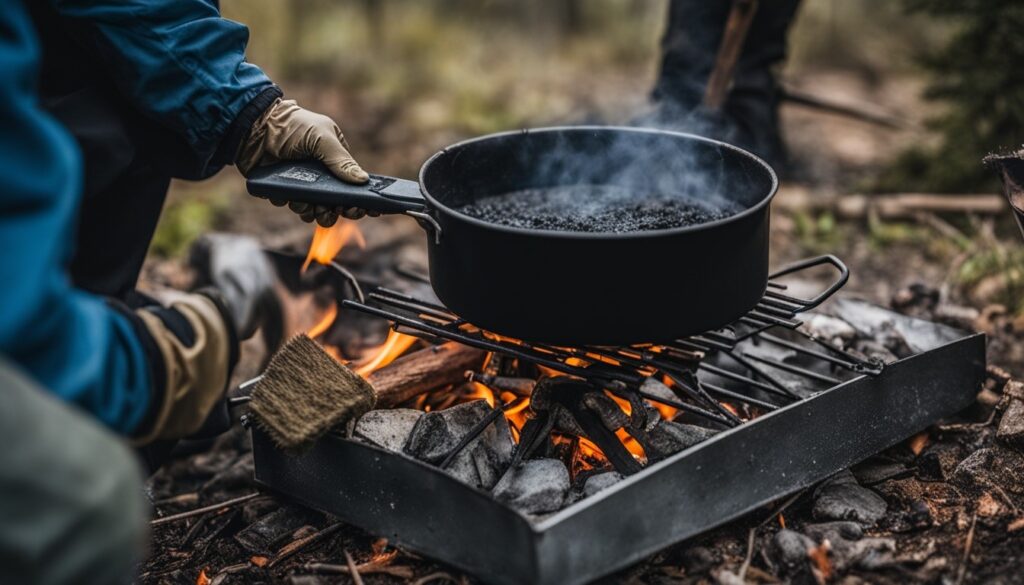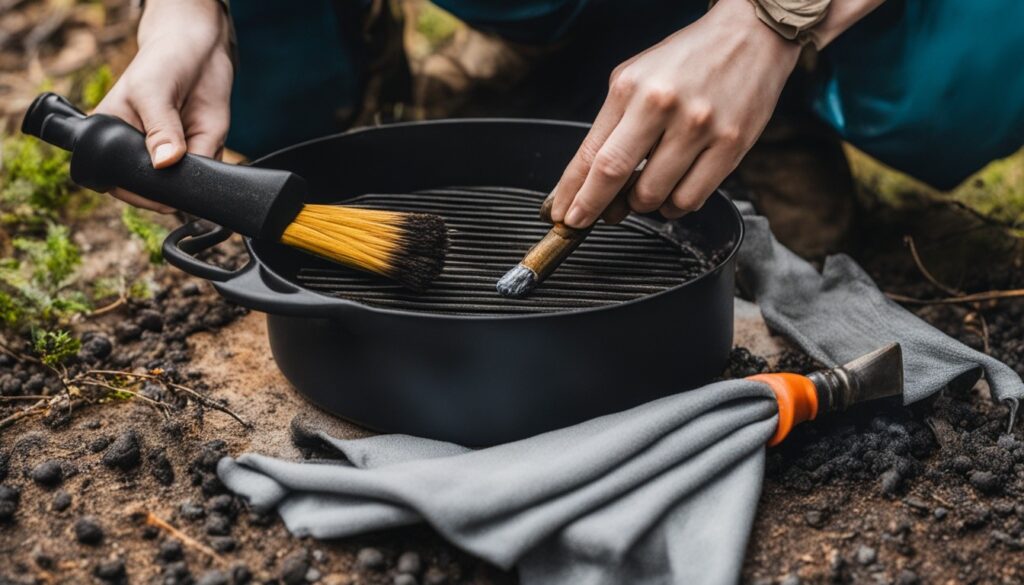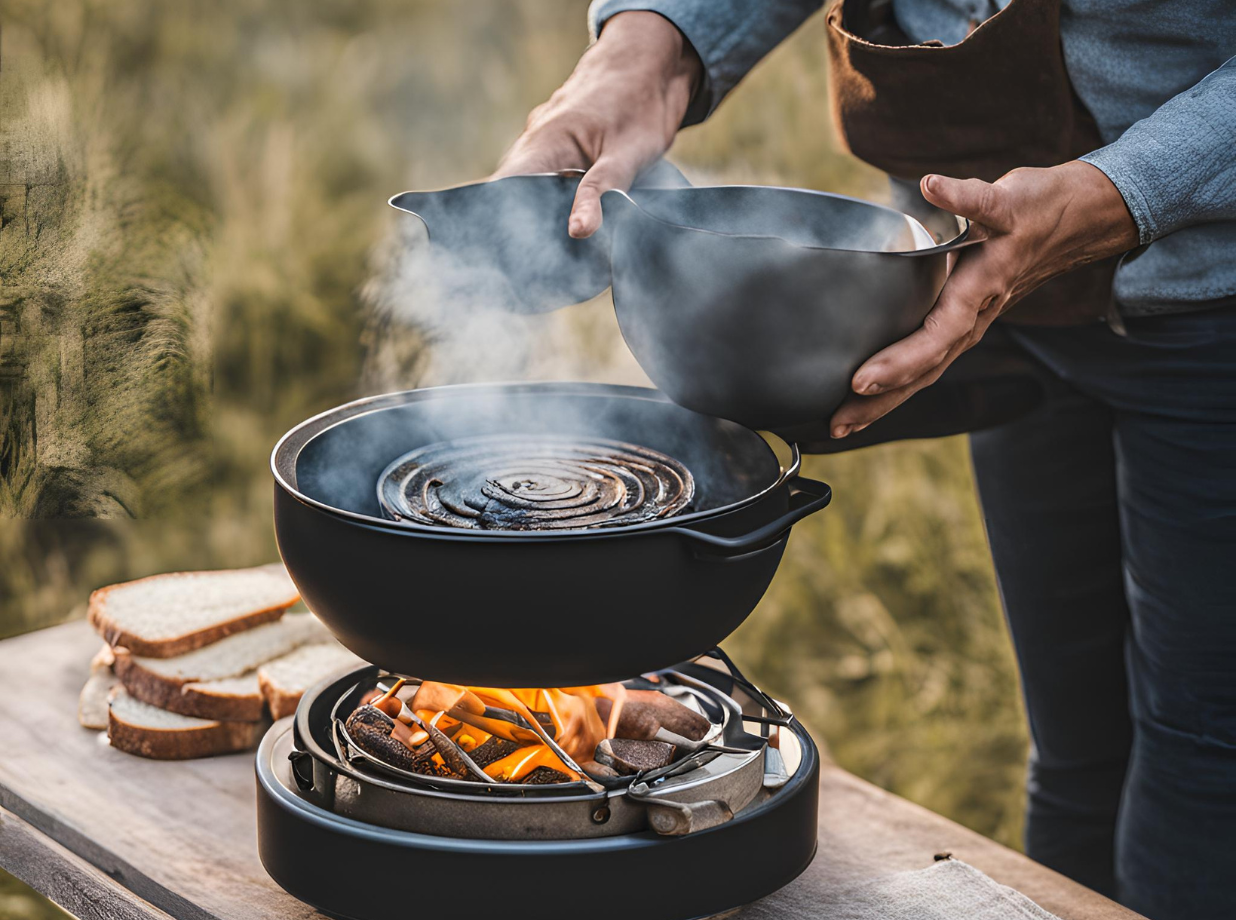Keeping your camping stove clean is key for a great outdoor cooking experience. Soot buildup can hurt the stove’s performance and make it look bad. This guide will show you how to clean soot off your camping stove easily. We’ll give you simple steps to keep your gear in great shape.

Show a camping stove placed outdoors on a rocky surface, with a camping pot and utensils nearby. The stove is covered in soot and dirt, with visible burn residue on the grates. Demonstrate the process of cleaning the stove, using a scrub brush and soap to remove the grime. Include before-and-after views of the stove, with the clean stove gleaming in the sunlight. Use earthy tones and natural textures to capture the ruggedness of the camping environment.
Key Takeaways
- Regularly cleaning soot off your camping stove is essential for optimal performance and longevity.
- Proper maintenance helps prevent damage and ensures a safer, more efficient cooking experience.
- Learn effective techniques, including using a soft-bristle brush and gentle abrasives, to remove stubborn soot buildup.
- Understand the importance of safety precautions when cleaning your camping stove.
- Establish a regular cleaning schedule to maintain a well-functioning and visually appealing outdoor cooking setup.
Introduction to Camping Stove Maintenance
Keeping your camping stove in good shape is key for its performance and life span. Cleaning off soot is a must to avoid clogs, save fuel, and keep your gear working right.
Why Cleaning Soot is Important
Soot and carbon can build up on your camping stove over time. This makes it less efficient and can cause problems. If you don’t clean it, fuel lines might get clogged, heat output drops, and it could be unsafe. A clean stove works better and lasts longer.
Benefits of Regular Maintenance
Regular upkeep of your camping stove, like cleaning soot, brings big advantages:
- Better fuel efficiency, which saves money on fuel and costs
- Longer life for your camping stove, which saves money over time
- Reliable performance for enjoyable outdoor cooking
- More safety by lowering the chance of accidents or problems
Spending a little time on stove cleaning brings big rewards. It helps you get the most from your camping stove and keeps your outdoor cooking gear in great shape for many years.
Prepare for Soot Removal
Before you start cleaning soot off your camping stove, make sure you have everything you need. This guide will walk you through the steps to prepare for cleaning. It ensures a smooth and effective way to remove soot.
Gathering Supplies for Soot Removal:
- Soft-bristle brush – to gently scrub the stove’s surface without causing damage
- Abrasive pads or sponges – for tackling stubborn soot buildup
- Cleaning solutions – such as warm soapy water or specialty stove cleaners
- Protective gloves – to keep your hands safe during the cleaning process
- Rags or paper towels – for wiping and drying the stove
Preparing the Work Area:
- Ensure your camping stove is unplugged and completely cooled down before beginning the cleaning process.
- Choose a well-ventilated area, preferably outdoors or in a well-lit room, to work on the stove.
- Lay down a clean, absorbent surface, such as a towel or a tarp, to catch any drips or debris during the cleaning.
- Have all your cleaning supplies within easy reach, so you can efficiently tackle the soot removal.
By preparing to clean your camping stove and gathering the necessary supplies for soot removal, you’re ready to make your stove shine again. Next, we’ll explore the best ways to clean soot from your stove.
“A clean, well-maintained camping stove not only looks better but also performs more efficiently and safely.”
Effective Soot Cleaning Techniques
Keeping your camping stove clean is key for its best performance and long life. There are several good ways to clean it. Let’s look at two top methods: using a soft-bristle brush and gentle abrasives.
Using a Soft-Bristle Brush
Using a soft-bristle brush is a simple yet effective way to clean soot off your camping stove. This gentle method removes soot without harming your stove’s surfaces. Just scrub the areas with a circular motion, focusing on tough spots.
Applying Gentle Abrasives
For tough soot, try gentle abrasives like baking soda or fine steel wool. Sprinkle baking soda on the soot, then clean it with a damp cloth or soft-bristle brush. The baking soda’s abrasive nature helps dissolve the soot, making your stove look new.
Combining these cleaning methods works best for effective soot removal on your camping stove. With a soft-bristle brush and gentle abrasives, your stove will look great and work well for your outdoor trips.
How to Clean Soot Off Camping Stove
Keeping your camping stove in top shape is key for reliable use and longevity. Removing soot buildup is a crucial task. It helps keep the stove efficient and safe. Here’s a step-by-step guide on cleaning soot off your camping stove for a thorough clean.
Begin by taking apart your camping stove. Remove the burners, grates, and any parts you can take out. This lets you get to all the spots where soot hides.
- Use a soft-bristle brush to gently scrub the burners. Remove any soot or residue. Make sure to clean the burner holes well for good fuel flow.
- For the grates, try a mild abrasive cleaner or baking soda and water. Use a soft sponge or cloth to scrub, focusing on tough spots.
- Wipe the stove’s outside with a damp cloth to remove surface soot. Don’t use harsh chemicals or rough scrubbers to avoid damage.
After cleaning, put your camping stove back together. Make sure everything fits right and is tight to avoid safety or performance issues.
“A clean camping stove not only looks better but also performs more efficiently, ensuring a reliable cooking experience every time.”
Regular maintenance and cleaning of your camping stove is vital. By following this guide, you can easily remove soot from your camping stove burners and clean your camping stove grates. This keeps your stove ready for your next outdoor trip.

A pair of gloved hands holding a dirty camping stove in one hand and a cleaning brush in the other, scrubbing off black soot residue. In the background, a tent and campfire can be faintly seen, suggesting an outdoor camping trip. The focus should be on the cleaning process, with the stove taking up most of the frame.
Stubborn Soot: Advanced Methods
When you’re up against tough soot on your camping stove, it’s time for advanced cleaning. Using a baking soda and vinegar mix is a great way to remove stubborn soot. This method is powerful and effective.
Using Baking Soda and Vinegar to Clean Camping Stove
Dealing with stubborn soot on your camping stove? Try a mix of baking soda and vinegar. These common items create a fizz that lifts even the toughest soot off your stove.
- Mix equal parts baking soda and white vinegar in a bowl. Use 1 tablespoon of each for a standard stove.
- Apply the mix to the soot with a soft brush or cloth.
- Wait a few minutes for the fizz to work its magic.
- Scrub the stove with a brush or cloth, focusing on the soot.
- Rinse with clean water to get rid of the mix.
- Dry the stove before you use it again.
This method with baking soda and vinegar is a powerful way to clean your camping stove. With some effort and this mix, your stove will look new in no time.
Safety Precautions for Soot Removal
Cleaning soot off your camping stove requires putting safety first. It’s important to take the right steps to protect yourself and ensure a safe cleaning process. Here are key safety tips for removing soot from your gear.
Gear Up for Protection
Wearing the right gear is a must. Always use sturdy gloves to protect your hands from soot and harsh cleaners. Safety goggles will keep your eyes safe from particles and irritation. If you’re working in a small space, a face mask can help prevent breathing in harmful fumes.
Ventilate the Area
Removing soot can fill the air with bad smells and toxic fumes. Make sure the area is well-ventilated by opening windows or using a fan. This helps move fresh air in and keeps you safe from harmful particles.
Proper Waste Disposal
After cleaning, throw away soot-covered materials like rags or cleaners in a bag. Make sure to follow your local waste rules for disposal. Not doing it right could harm the environment or pose safety risks.
“Taking the necessary safety precautions when cleaning your camping stove can make all the difference in protecting your health and ensuring a successful, stress-free experience.”
By using these safety tips, you can safely clean your camping stove. Remember, safety first is the key to a successful and easy maintenance routine.

A person wearing gloves and safety glasses while cleaning soot off a camping stove with a brush and damp cloth. The surrounding area is clear of any flammable objects and there is a fire extinguisher nearby.
Maintaining a Clean Camping Stove
Keeping your camping stove clean is key for its long life and best performance. Regular cleaning stops soot from building up. This keeps the stove working well and safe. By cleaning it often, your camping stove will always be ready for your outdoor trips.
Regular Cleaning Schedule
How often you clean your camping stove depends on how much you use it and how much soot it gets. Here’s a basic cleaning plan:
- Lightly Used Stoves: Clean your stove after a few uses or once a month, whichever is first.
- Heavily Used Stoves: Clean it after every use, or at least once a week, to keep it running well.
- Stoves with Significant Soot Buildup: Clean it well before and after long trips or heavy use.
Following this cleaning plan helps you keep your camping stove clean and reliable. It’s important to clean it often. This schedule keeps your outdoor cooking gear in great shape for your adventures.
“Keeping your camping stove clean is key to its longevity and performance. A consistent cleaning routine will ensure your stove remains a trusty companion on all your outdoor excursions.”
Troubleshooting Common Soot Issues
Keeping your camping stove clean is key, but even careful campers face soot problems. We’ll look at common soot issues and offer solutions to keep your gear in great shape.
Using the wrong fuel is a big soot cause. The wrong fuel or overfilling can lead to incomplete burning, making lots of soot. Make sure to use the fuel recommended by the maker and fill it right.
Poor ventilation also causes soot problems. If the stove doesn’t get enough air, it can’t burn properly, leading to soot buildup. Place your stove where it gets good air flow and keep vents clean to help it burn right.
Frequently Asked Questions
What is the importance of cleaning soot off my camping stove?
Cleaning your camping stove regularly is key for its performance and life span. Soot can block fuel lines, lower efficiency, and increase fire risk. A clean stove uses fuel better, works reliably, and lasts longer.
What are the benefits of regular camping stove maintenance?
Keeping your camping stove clean is beneficial. It stops clogs, saves fuel, and keeps it working well. This care also makes your stove last longer, saving money over time.
What supplies do I need to clean soot off my camping stove?
You’ll need a soft-bristle brush, gentle abrasives like baking soda or fine steel wool, a mild cleaner, rags, and safety gear. Make sure your stove is off and cool before you start cleaning.
How can I use a soft-bristle brush to clean soot off my camping stove?
Use a soft-bristle brush to clean soot off your stove. Gently scrub the areas to remove soot. Focus on the burners, grates, and hard-to-reach spots for a complete clean.
What is the best way to use gentle abrasives to remove stubborn soot?
For tough soot, use gentle abrasives like baking soda or fine steel wool. Wet the area, add the abrasive, and scrub with a soft brush or sponge. This breaks down and removes hard soot.
How can I use a baking soda and vinegar solution to clean my camping stove?
Try a baking soda and vinegar paste for hard soot. Mix equal parts, apply to the stove, and let it sit. Then, scrub with a soft brush. The reaction between the ingredients loosens and removes soot.
What safety precautions should I take when cleaning soot off my camping stove?
Be safe when cleaning your stove. Wear gloves and eye protection to avoid irritation. Clean in a well-ventilated area and dispose of materials safely.
How often should I clean my camping stove to maintain it?
Clean your stove after 3-5 uses or when soot builds up. A regular cleaning schedule keeps your stove in good shape.
What are some common soot-related issues I might encounter with my camping stove?
Issues like clogged fuel lines, low efficiency, and fire risks can happen. These come from bad fuel use, poor air flow, or not cleaning enough. Fixing these problems keeps your stove clean and efficient.



